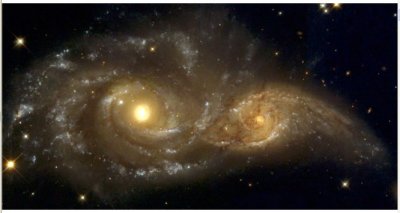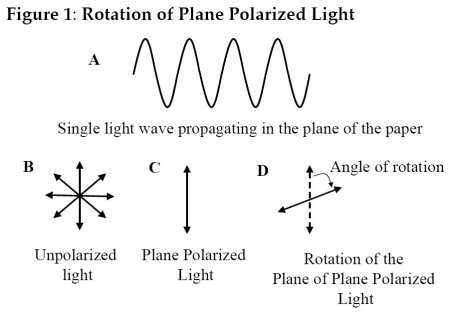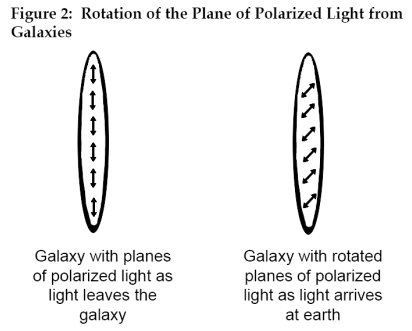Starlight and Time: Scripture and Science Support a Young Earth Cosmology
One scientific challenge young earth creationists have had to address is the starlight-time question.

From NASA: Binary spiral galaxies NGC 2207 (left) and IC 2163 (right) are estimated to be 114 million light years away from Earth
That is, if the creation is only 6-10 thousand years old as the scriptures imply, how is it possible for us to see stars and galaxies which are billions of light years away? There have been several solutions advanced to solve this problem including decay of the speed of light, light created in transit, mature creation theory, and physicist Russ Humphreys' white hole cosmology (WHC) 1 theory, among others. This article will discuss Russ Humphreys' white hole cosmology and reply to some recent criticisms of it made by astronomer Hugh Ross. 2
Humphreys' WHC theory is both biblically and scientifically sound. The creation account (Genesis 1) is taken in a straight forward manner as history with the sequence of events and durations accepted as stated. From scripture, Humphreys finds support for a finite extent of matter in the universe (Ps 147:4), the expansion of space 3 (Ps 104:2), and the young age of the earth (creation week and genealogies) among other things. 4 He uses these clues combined with relativity to formulate his WHC. Scientifically, the theory incorporates the relativistic effect known as gravity-time dilation. Einstein's theory of relativity predicts, and experiment has verified, that all physical processes in different gravity fields proceed at different rates; the greater the gravity, the slower the processes. Dr. Humphreys has shown that in a finite and expanding universe with the Milky Way galaxy near its center, 5 the gravity field at the earth may have been greater than that of the distant cosmos on day 4 of creation week. Hence clocks on earth would have ticked much more slowly than clocks in the distant cosmos; while only hours passed on the earth, billions of years worth of physical processes took place in the distant cosmos allowing starlight from these regions to reach the earth by the evening of day 4.
Whether or not the universe unfolded as described in the WHC theory depends on the history of the distribution of matter in the cosmos. The Big Bang theory assumes that the density of matter in the universe (taken at large enough scale) has been essentially the same in all places at any given time. This means that there has never been a center of mass or any place where the gravity has been significantly different than any other place (again, taken on a large enough scale). This assumption, referred to as the Copernican Principle, says that the universe is homogeneous and isotropic (that the universe looks the same regardless of where you go in it or in what direction you look) and therefore has no special places. If this is true, no gravity-time dilation effects would have been operative during the unfolding of the universe and the WHC would be invalid. In contrast, the WHC theory holds that there is an edge to the matter in the universe beyond which the density drops dramatically. The WHC pictures the matter of the universe distributed evenly within a defined volume beyond which is empty space. Astronomers refer to this type of cosmic geometry as bounded, because it says the matter in the universe has a boundary or edge. Further, our galaxy, the Milky Way, is thought to be close to the center of the volume, a very special place indeed. The gravity in this configuration of matter would vary from place to place being stronger near the center. If this picture of the cosmos is correct, then the gravity-time dilation effects mentioned above would have been operative during creation week as the WHC theory claims.
The question naturally arises: is there any evidence that can help determine which view of the distribution of matter in the universe is correct? Dr. Humphreys advances two possibilities: quantized galactic redshifts 6 ,7 ,8 and polarized radiation from galaxies 9 ,10 ,11 ,12 and from the cosmic microwave background (CMB). 13 ,14 ,1
The frequencies of light emitted by a star contain information about the elements from which the star is made. Each element has a spectral fingerprint. Most stars consist primarily of hydrogen. Edwin Hubble in the 1920s discovered that light from some "nebulae" had the fingerprints of the expected elements from stars, but that usually all the frequencies were shifted to longer wavelengths, that is, redshifted. Hubble went on to demonstrate that the redshift of the frequencies of light correlated with the distance to and the recession velocity of an object; the greater the redshift, the greater the distance and recession speed. The nebulae were found to lie beyond the boundary of the Milky Way, a revolutionary discovery. Hubble soon realized that the nebulae were other galaxies which were moving away from us, and the farther away, the faster the recession. Hubble's results confirmed a prediction of Einstein's general theory of relativity, that the universe is either expanding or contracting. Nowadays, astronomers routinely use redshifts as a distance measure. Recently, secular astronomers have discovered that the redshifts of galaxies in our cosmic neighborhood are bunched together at various regular intervals out to about a billion light years, 15 that is, they are quantized. The effect is seen beyond a billion light years for some intervals, but to a lesser extent for others, and appears to eventually fade. The implication of these observations is that relatively nearby galaxies are distributed in concentric spheres with the Milky Way near the center. Computer simulations have shown that the galactic redshifts viewed from a location just a few million light years away from the Milky Way would not show quantization but merely a random distribution; only observers in just the right place will see the effect. These findings are contrary to the Copernican Principle, the foundation of the Big Bang theory, because they suggest that there may be unique and special places such as a center to the mass of the universe.
For example, consider the conclusions drawn by noncreationist authors who recently analyzed the data from "pencil beam" galactic redshift surveys:
But probably the most puzzling discovery concerns the recent observations which show an apparent periodicity [regular interval] in the distribution of redshifts in pencil-beam surveys of the north and south galactic polar regions These surveys extend to a redshift of around z = 0.5 [4.8 billion light years] 16 in both directions, and there is a strong evidence for a periodicity of 128h-1 Mpc [410 million light years] which extends for over 13 periods. Although this result was considered initially a statistical anomaly, later and more detailed studies provided new evidence for the alluded periodicity on the same scales.
If this periodicity would be established in most directions, a naive interpretation would imply that galaxies and [galaxy] clusters are distributed on concentric shells centered around our galaxy, clearly a blow to our cosmological conceptions. Another more plausible explanation is based upon the idea that the observed periodicity is just a visual effect induced by a periodic oscillation of the gravitational constant, and that the mass density of the Universe on intermediate scales remains homogeneous and isotropic as on the largest scales. 17 ,18
Notice that the bunching of galactic redshifts at regular intervals is not questioned. Interestingly, the most straight forward interpretation of the data, that the Milky Way is located at the center of a series of concentric shells of galaxies, is rejected as "naive" in favor of a purely speculative explanation which lacks any precedent or empirical foundation.
Progressive creationist Hugh Ross recently cited 2 a paper 19 that he claimed refuted the whole notion of quantized galactic redshifts, but he was mistaken. The authors of the paper argued only that there was no special periodic pattern to the redshifts of quasi-stellar objects (QSOs) which appear to be physically connected to some galaxies; the subject of galactic redshifts per se was not addressed. Some scientists have suggested that QSOs were ejected from "active" galaxies and that the apparent quantized redshifts of these QSOs are evidence of this alleged causal history. The paper cited by Ross disputed the quantized QSO claim, nothing else. Furthermore, a paper more recent 20 [quoted above] than the one cited by Ross not only cited the same paper but concluded the quantization of galactic redshifts on large scales is well established while those on small scales deserve more research. The point here is that no study has been reported that rules out quantized galactic redshifts, contrary to Ross.
What physical process could account for a periodic distribution of galaxies? Dr Humphreys explains:
If God used processes as part of His making the stars and galaxies on the fourth day of Creation, then redshift quantizations are evidence that some of the processes were spherically symmetric around our galaxy. For example, we could imagine spherical shock waves bouncing back and forth between the centre and edge of an expanding ball of gas or plasma, such as in the tentative cosmogony I outline in Starlight and Time.
The reverberating waves would interfere with each other at some radii and enhance each other at other radii, setting up a pattern of 'standing waves,' concentric shells of denser gas. God would then gather the gas into stars and galaxies. The resulting concentric patterns of galaxies would be complex, having many spacings corresponding to the many different modes of reverberation...
Standing waves imply the matter had an outer edge for the shock waves to rebound from. That would make the geometric centre be a centre of mass also. If we put those boundary conditions (an edge and centre) into Einstein's equations of general relativity, we get the cosmology I presented in Starlight and Time. The centre of mass is a centre for gravitational forces, low in intensity but cosmic in extent. Then gravity causes large time dilation effects at the centre during one particular stage of the expansion. 6
Hence, quantized galactic redshifts on various scales are supported by much evidence and are completely consistent with Dr. Humphreys' finite model of the universe with the Milky Way near the center.

Figure 1
The second phenomenon which supports the bounded model of the universe with special places and directions is the polarization of radiowaves from galaxies and the CMB. Light (and all electromagnetic radiation) moves through space as waves in planes (Figure 1, A). Usually, light from a given source is propagating in all possible planes (Figure 1, B). However, sometimes light is polarized, that is, most if the light coming from a source propagates in a single plane (Figure 1, C). Such light is known as plane polarized light. Now it is well known that the plane of polarized light can be rotated by magnetic fields (Figure 1, D). In other words, if you could look at a light wave coming towards you edge on, you would see a straight line representing the amplitude of the wave. Now if some external magnetic field were applied between the light source and you, the orientation of the line would rotate as it traveled through space. The angular difference between the line before and after application of the external magnetic field would be the angle of rotation of the plane of the light wave.
Now, the light waves from galaxies tends to propagate in the plane of the galaxy (Figure 2).

Figure 2
What has been observed is that the angle of rotation of the plane of polarization of radiowaves from galaxies increases more in some parts of the sky than others and as a function of distance.
The rotation angle increases from zero to a maximum when looking in the direction of the constellations Virgo and then back to zero as one observes through an arc of 180 degrees. This pattern is again repeated in the opposite direction (but the rotation angle is now negative). The angle of rotation also increases the greater the distance of the galaxy. The microwave radiation of the CMB is also polarized in a fashion and direction similar to that of the radiowaves from galaxies.
These results imply the cosmos has an axis. Dr. Humphreys believes this is an axis of rotation, and he discusses this possibility in Starlight and Time. The movement of matter through space in a rotating cosmos could generate a weak magnetic field 21 which could account for the rotation of the plane of polarized light from galaxies and the CMB.
Dr. Ross claims 2 that a recent paper 22 has discounted the evidence for a cosmic rotation axis, but again he is mistaken. The paper does not even mention or address the phenomena of the polarization of light from galaxies or the CMB or its implications concerning a cosmic axis. The subject of the paper was the small change in the frequency of radiowaves from distant galaxies caused by the motion of our galaxy through space; the light from galaxies in the direction of our motion should be slightly blueshifted whereas the light from galaxies in the opposite direction should be slightly redshifted. The authors were able to detect the effect by taking into account (subtracting) the effects of nearby galaxies on the measurements. That the rotation of the plane of polarized light from galaxies and the CMB cannot be explained by the motion of our galaxy through space is demonstrated by the fact that the angle of rotation depends upon the distance to a galaxy and is hence not a local effect; something is causing the plane of the light to rotate on its way to us through space independent of our motion.
In conclusion, a finite and bounded universe with an edge and center of mass could unfold with the gravity time dilation effects described in Dr. Humphreys' WHC. The unrefuted observations of quantized galactic redshifts and polarization of radiowaves from distant galaxies and the CMB support a finite and bounded model of the universe, but are less compatible with the Copernican principle, the basis of big bang cosmologies. Hugh Ross' criticisms of these phenomena miss the mark. The picture that emerges is a slowly rotating cosmos of finite extent defined by an edge and with the Milky Way located near the center surrounded by concentric spheres of galaxies spaced at various regular intervals deep into the cosmic radius. This picture is consistent with the Bible and science, as Dr Humphreys has shown.
- 1 a b Humphreys, D. Russell. (1994) Starlight and Time, Master Books, Green Forest, Arkansas; DVD: (2005) Starlight and Time - Updated and Expanded featuring physicist Russell Humphreys, Answers in Genesis, Petersburg, Kentucky.
- 2 a b c Ross, Hugh. (2004) A Matter of Days, NavPress, Colorado Springs, Colorado.
- 3Note that the scriptures spoke of the expansion of space thousands of years before Edwin Hubble discovered galactic redshifts, the scientific evidence for the expansion of the universe, in the early 20th century.
- 4Only the highpoints of Dr. Humphreys' theory will be covered here. For a detailed discussion, see reference 1.
- 5Scripture does not explicitly state that the Milky Way and earth are near the center of the universe, but the concept is in keeping with the order of creation (earth first) and the purpose of all celestial objects (Gen 1:14-19) to provide light and time markers for earth's inhabitants.
- 6 a b Humphreys, Russell D. (2002) Creation Ex Nihilo Technical J, 16(2): 1-10
- 7Napier, W.M., Guthrie, B.N.G. (1997) J. Astrophys. Astr. 18: 455-463.
- 8Cohen, J.G., et al. (1996) The Astrophysical Journal, 471: L5-L9
- 9Nodland, Borge., Ralston, J.P. (1997) Physical Review Letters, 78: 3043
- 10Rainer, W. Kuhnear (1997) Xiv:astro-ph/9708109 v1 12 Aug
- 11Yuri N. Obukhov et al. (1997) arXiv:astro-ph/9705243 v1 30 May
- 12Jain, P., Ralston, J.P. (1999) Particles and Fields; Gravitation; Cosmology and Nuclear Physics, Modern Physics Letters A,14 (6): 417-432
- 13Humphreys, Russell D. (2003) Act and Facts, May 4
- 14Tegmark, M., de Olivera-Costa, A. (2003) Phys. Rev. D, 68:123523
- 15The diameter of the universe is thought to be 20-30 billion light years. If the Milky Way is near the center, one billion light years would be about one-tenth to one-fifteenth of the cosmic radius.
- 16Hubble's Law: z =Δλ/λ = v/c; v = Hr; z=Hr/c or r = zc/H; H = 100 km/s/Mpc; c = 300,000 km/s; Mpc = 3,200,000 light years; therefore R(distance) = 0.5 (300,000 km/s)/100 km/s/Mpc) = 1,500 Mpc = 4.8 billion light years
- 17Jose A. Gonzalez et al. (2000) Astron.Astrophys. 362:835- 839. Also see ref. 17.
- 18Dr. Humphreys has not mentioned this particular large scale quantization in his writings.
- 19Hawkins, E., Maddox, S. J., Merrifield, M. R. (2002) Mon. Not. R. Astron. Soc., 336: L13-L16
- 20Bajan, Katarzyna. (2003) Spacetime & Substance, 4 No. 5 (20): 225-228
- 21This is called the gravitomagnetic effect and comes from the theory of general relativity. Dr. Humphreys mentions this effect in his more recent video cited in reference 1.
- 22Blake, C, Wall, J (2002) Nature, 416: 150-152 Last Updated ( Oct 08, 2005 at 11:44 AM )